Agent-Based Modeling of the Hajj Rituals with the Possible Spread of COVID-19
Abstract
:1. Introduction
2. Methods
2.1. Environment
2.2. Disease Dynamics
2.3. Crowd Mobility Behavior
- Agents located at a far distance from their goal move slightly faster.
- Agents always pick the next patch to become closer to the goal while avoiding collisions with the environment and other agents.
- Agents adapt to crowding by moving slightly outwards in order to allow some space for flow from within the crowd. This was necessary in order to avoid the agents inside the crowd becoming stuck.
- In Ramy al-Jamarat, the agents adapt their movement by always picking the shortest exit based on their current position.
2.4. Control Measures
2.5. Evaluation Metrics
3. Results and Discussion
3.1. Effect of the Control Measures on the Prevalence and the Infected Reproduction Number
3.1.1. Tawaf
3.1.2. Ramy al-Jamarat
3.1.3. Effect of Coupling Crowd Control with Preventative Control Measures
3.1.4. Tawaf
3.1.5. Ramy al-Jamarat
4. Conclusions
Author Contributions
Funding
Acknowledgments
Conflicts of Interest
References
- Al-Shaery, A.M.; Alshehri, S.S.; Farooqi, N.S.; Khozium, M.O. In-Depth Survey to Detect, Monitor and Manage Crowd. IEEE Access 2020, 8, 209008–209019. [Google Scholar] [CrossRef]
- Felemban, E.A.; Rehman, F.U.; Biabani, S.A.A.; Ahmad, A.; Naseer, A.; Majid, A.R.M.A.; Hussain, O.K.; Qamar, A.M.; Falemban, R.; Zanjir, F. Digital Revolution for Hajj Crowd Management: A Technology Survey. IEEE Access 2020, 8, 208583–208609. [Google Scholar] [CrossRef]
- Alshammari, S.M.; Mikler, A.M. Big Data Opportunities for Disease Outbreaks Detection in Global Mass Gatherings. In Proceedings of the 2018 International Conference on Big Data and Education, Honolulu, HI, USA, 9 March 2018; pp. 16–21. [Google Scholar]
- Farooqi, N. Intelligent Safety Management System for Crowds Using Sensors. In Proceedings of the 2017 12th International Conference for Internet Technology and Secured Transactions (ICITST), Cambridge, UK, 11–14 December 2017; pp. 144–147. [Google Scholar]
- Owaidah, A.; Olaru, D.; Bennamoun, M.; Sohel, F.; Khan, N. Review of Modelling and Simulating Crowds at Mass Gathering Events: Hajj as a Case Study. JASSS 2019, 22, 9. [Google Scholar] [CrossRef]
- Rahman, A.; Hamid, N.A.W.A.; Rahiman, A.R.; Zafar, B. Towards Accelerated Agent-Based Crowd Simulation for Hajj and Umrah. In Proceedings of the 2015 International Symposium on Agents, Multi-Agent Systems and Robotics (ISAMSR), Putrajaya, Malaysia, 18–19 August 2015; pp. 65–70. [Google Scholar]
- Mahmood, I.; Haris, M.; Sarjoughian, H. Analyzing Emergency Evacuation Strategies for Mass Gatherings Using Crowd Simulation and Analysis Framework: Hajj Scenario. In Proceedings of the 2017 ACM SIGSIM Conference on Principles of Advanced Discrete Simulation, Singapore, 24–26 May 2017; pp. 231–240. [Google Scholar]
- Nasser, N.; el Ouadrhiri, A.; el Kamili, M.; Ali, A.; Anan, M. Crowd Management Services in Hajj: A Mean-Field Game Theory Approach. In Proceedings of the 2019 IEEE Wireless Communications and Networking Conference (WCNC), Marrakesh, Morocco, 15–18 April 2019; pp. 1–7. [Google Scholar]
- Silva, P.C.L.; Batista, P.V.C.; Lima, H.S.; Alves, M.A.; Guimarães, F.G.; Silva, R.C.P. COVID-ABS: An Agent-Based Model of COVID-19 Epidemic to Simulate Health and Economic Effects of Social Distancing Interventions. Chaossolitons Fractals 2020, 139, 110088. [Google Scholar] [CrossRef] [PubMed]
- Cuevas, E. An Agent-Based Model to Evaluate the COVID-19 Transmission Risks in Facilities. Comput. Biol. Med. 2020, 121, 103827. [Google Scholar] [CrossRef]
- Kerr, C.C.; Stuart, R.M.; Mistry, D.; Abeysuriya, R.G.; Rosenfeld, K.; Hart, G.R.; Núñez, R.C.; Cohen, J.A.; Selvaraj, P.; Hagedorn, B.; et al. Covasim: An Agent-Based Model of COVID-19 Dynamics and Interventions. Epidemiology 2020. [Google Scholar] [CrossRef]
- Hoertel, N.; Blachier, M.; Blanco, C.; Olfson, M.; Massetti, M.; Rico, M.S.; Limosin, F.; Leleu, H. A Stochastic Agent-Based Model of the SARS-CoV-2 Epidemic in France. Nat. Med. 2020, 26, 1417–1421. [Google Scholar] [CrossRef]
- Memish, Z.A.; Zumla, A.; Alhakeem, R.F.; Assiri, A.; Turkestani, A.; Al Harby, K.D.; Alyemni, M.; Dhafar, K.; Gautret, P.; Barbeschi, M.; et al. Hajj: Infectious Disease Surveillance and Control. Lancet 2014, 383, 2073–2082. [Google Scholar] [CrossRef]
- Memish, Z.A.; Al-Tawfiq, J.A. The Hajj in The Time of an Ebola Outbreak in West Africa. Travel Med. Infect. Dis. 2014, 12, 415–417. [Google Scholar] [CrossRef]
- Memish, Z.A.; Steffen, R.; White, P.; Dar, O.; Azhar, E.I.; Sharma, A.; Zumla, A. Mass Gatherings Medicine: Public Health Issues Arising from Mass Gathering Religious and Sporting Events. Lancet 2019, 393, 2073–2084. [Google Scholar] [CrossRef]
- Alotaibi, B.M.; Yezli, S.; Bin Saeed, A.-A.A.; Turkestani, A.; Alawam, A.H.; Bieh, K.L. Strengthening Health Security at the Hajj Mass Gatherings: Characteristics of the Infectious Diseases Surveillance Systems Operational during the 2015 Hajj. J. Travel Med. 2017, 24. [Google Scholar] [CrossRef]
- Shinde, K.A.; Olsen, D.H. (Eds.) Disease and Health Risks at Mass Religious Gatherings. In Religious Tourism and the Environment; CABI: Wallingford, UK, 2020; pp. 116–132. [Google Scholar]
- Atique, S.; Itumalla, R. Hajj in the Time of Covid-19. Infect. Dis. Health 2020, 25, 219–221. [Google Scholar] [CrossRef]
- Hoang, V.-T.; Gautret, P.; Memish, Z.A.; Al-Tawfiq, J.A. Hajj and Umrah Mass Gatherings and Covid-19 Infection. Curr. Trop. Med. Rep. 2020, 7, 133–140. [Google Scholar] [CrossRef] [PubMed]
- Jokhdar, H.; Khan, A.; Asiri, S.; Motair, W.; Assiri, A.; Alabdulaali, M. COVID-19 Mitigation plans During Hajj 2020: A Success Story of Zero Cases. Health Secur. 2020, 19, 133–139. [Google Scholar] [CrossRef] [PubMed]
- Alzahrani, S.I.; Aljamaan, I.A.; Al-Fakih, E.A. Forecasting the Spread of the COVID-19 Pandemic in Saudi Arabia Using ARIMA Prediction Model under Current Public Health Interventions. J. Infect. Public Health 2020, 13, 914–919. [Google Scholar] [CrossRef] [PubMed]
- Ahmad, N. Covid-19 Modeling in Saudi Arabia Using the Modified Susceptible-Exposed-Infectious-Recovered (Seir) Model. Cureus 2020, 12. [Google Scholar] [CrossRef]
- Al-Khani, A.M.; Khalifa, M.A.; Almazrou, A.; Saquib, N. The SARS-CoV-2 Pandemic Course in Saudi Arabia: A Dynamic Epidemiological Model. Infect. Dis. Model. 2020, 5, 766–771. [Google Scholar] [CrossRef]
- Algaissi, A.A.; Alharbi, N.K.; Hassanain, M.; Hashem, A.M. Preparedness and Response to Covid-19 in Saudi Arabia: Building on Mers Experience. J. Infect. Public Health 2020, 13, 834–838. [Google Scholar] [CrossRef]
- Nurunnabi, M. The Preventive Strategies of COVID-19 Pandemic in Saudi Arabia. J. Microbiol. Immunol. Infect. 2021, 54, 127–128. [Google Scholar] [CrossRef]
- Majra, D.; Benson, J.; Pitts, J.; Stebbing, J. SARS-CoV-2 (COVID-19) Superspreader Events. J. Infect. 2021, 82, 36–40. [Google Scholar] [CrossRef]
- Memish, Z.A.; Ahmed, Y.; Alqahtani, S.A.; Ebrahim, S.H. Pausing Superspreader Events for COVID-19 Mitigation: International Hajj Pilgrimage Cancellation. Travel Med. Infect. Dis. 2020, 36, 101817. [Google Scholar] [CrossRef]
- Zumla, A.; Azhar, E.I.; Alqahtani, S.; Shafi, S.; Memish, Z.A. COVID-19 and the Scaled-down 2020 Hajj Pilgrimage—Decisive, Logical and Prudent Decision Making by Saudi Authorities Overcomes Pre-Hajj Public Health Concerns. Int. J. Infect. Dis. 2020, 99, 34–36. [Google Scholar] [CrossRef]
- Sklar, E. Netlogo, a Multi-Agent Simulation Environment. Artif. Life 2007, 13, 303–311. [Google Scholar] [CrossRef]
- Chu, D.K.; Akl, E.A.; Duda, S.; Solo, K.; Yaacoub, S.; Schünemann, H.J.; Chu, D.K.; Akl, E.A.; El-harakeh, A.; Bognanni, A.; et al. Physical Distancing, Face Masks, and Eye Protection to Prevent Person-to-Person Transmission of SARS-CoV-2 and COVID-19: A Systematic Review and Meta-Analysis. Lancet 2020, 395, 1973–1987. [Google Scholar] [CrossRef]
- Lyu, W.; Wehby, G.L. Community Use of Face Masks and Covid-19: Evidence from a Natural Experiment of State Mandates in the Us: Study Examines Impact on Covid-19 Growth Rates Associated with State Government Mandates Requiring Face Mask Use in Public. Health Aff. 2020, 39, 1419–1425. [Google Scholar] [CrossRef] [PubMed]
- Liang, M.; Gao, L.; Cheng, C.; Zhou, Q.; Uy, J.P.; Heiner, K.; Sun, C. Efficacy of Face Mask in Preventing Respiratory Virus Transmission: A Systematic Review and Meta-Analysis. Travel Med. Infect. Dis. 2020, 36, 101751. [Google Scholar] [CrossRef] [PubMed]
- Mizumoto, K.; Kagaya, K.; Zarebski, A.; Chowell, G. Estimating the Asymptomatic Proportion of Coronavirus Disease 2019 (COVID-19) Cases on Board the Diamond Princess Cruise Ship, Yokohama, Japan, 2020. Euro Surveill. 2020, 25, 2000180. [Google Scholar] [CrossRef] [PubMed] [Green Version]
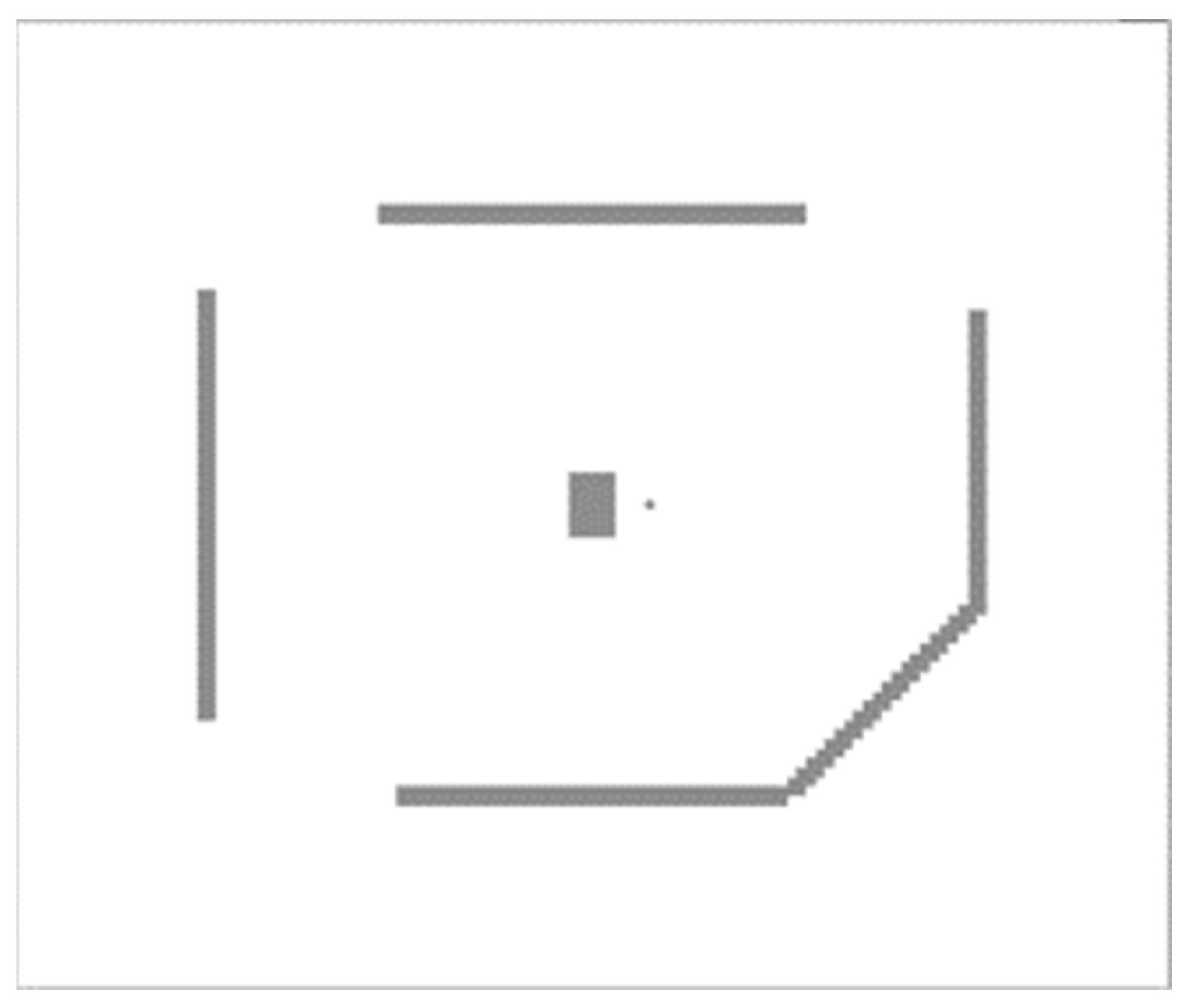
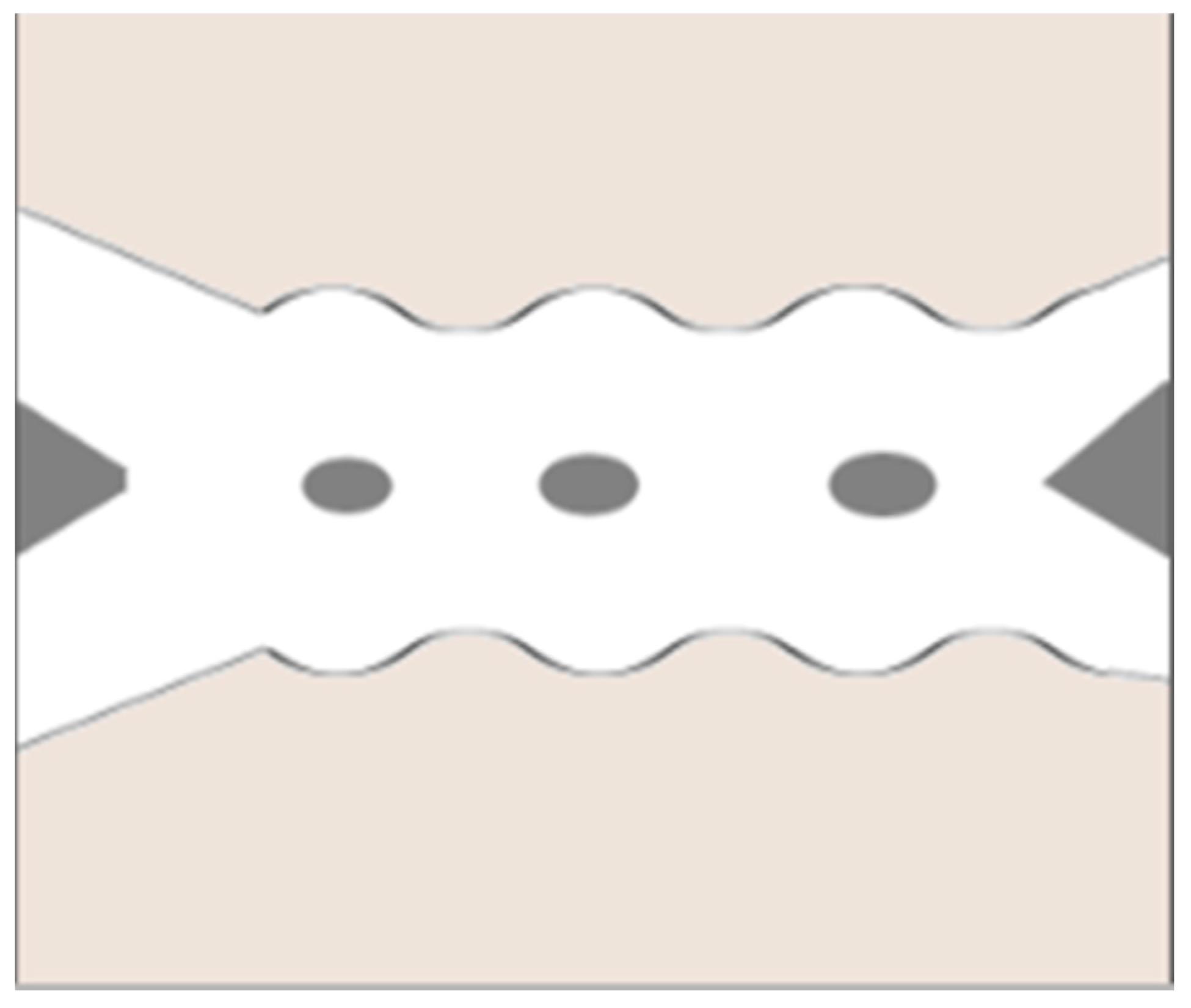
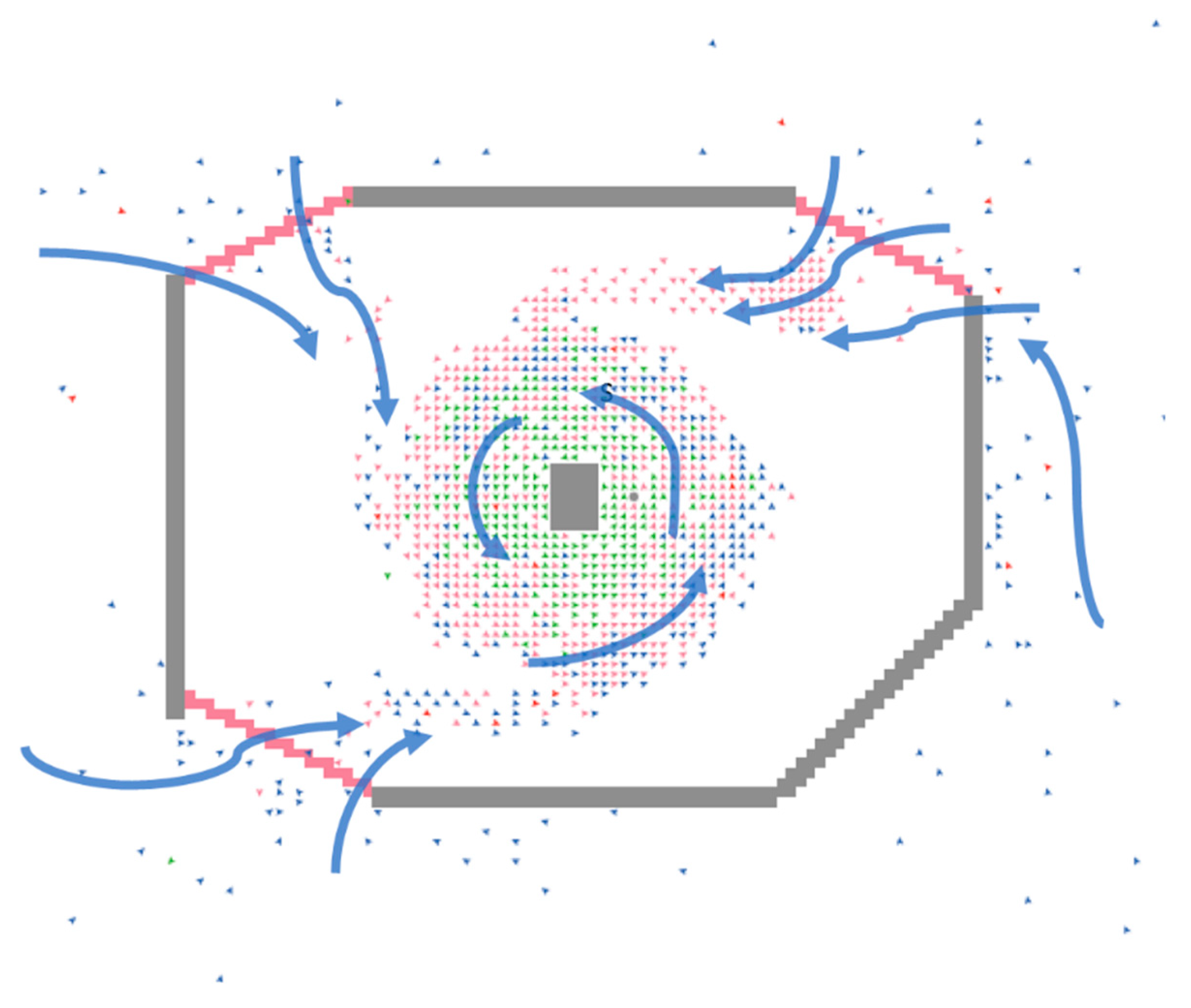

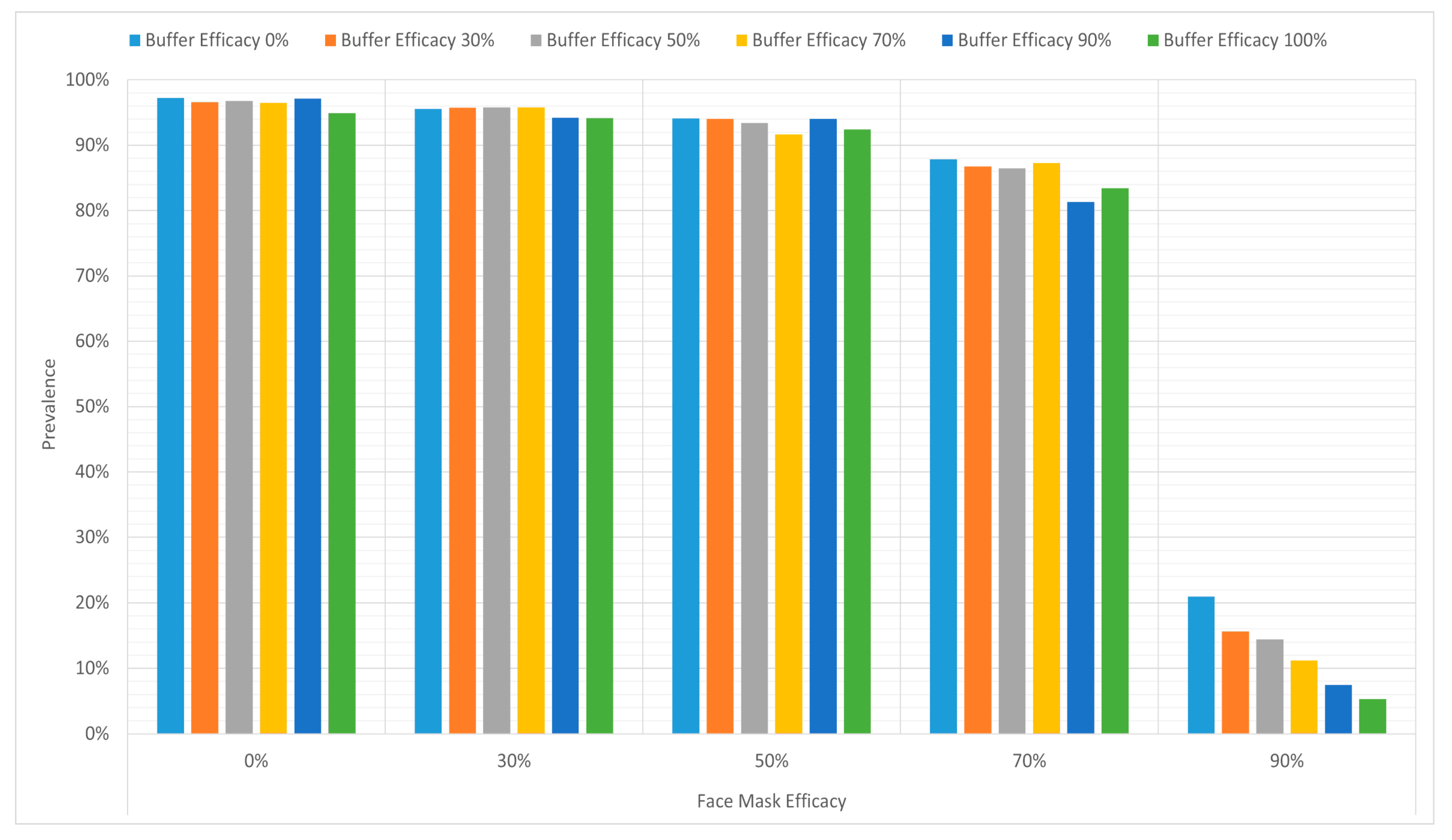
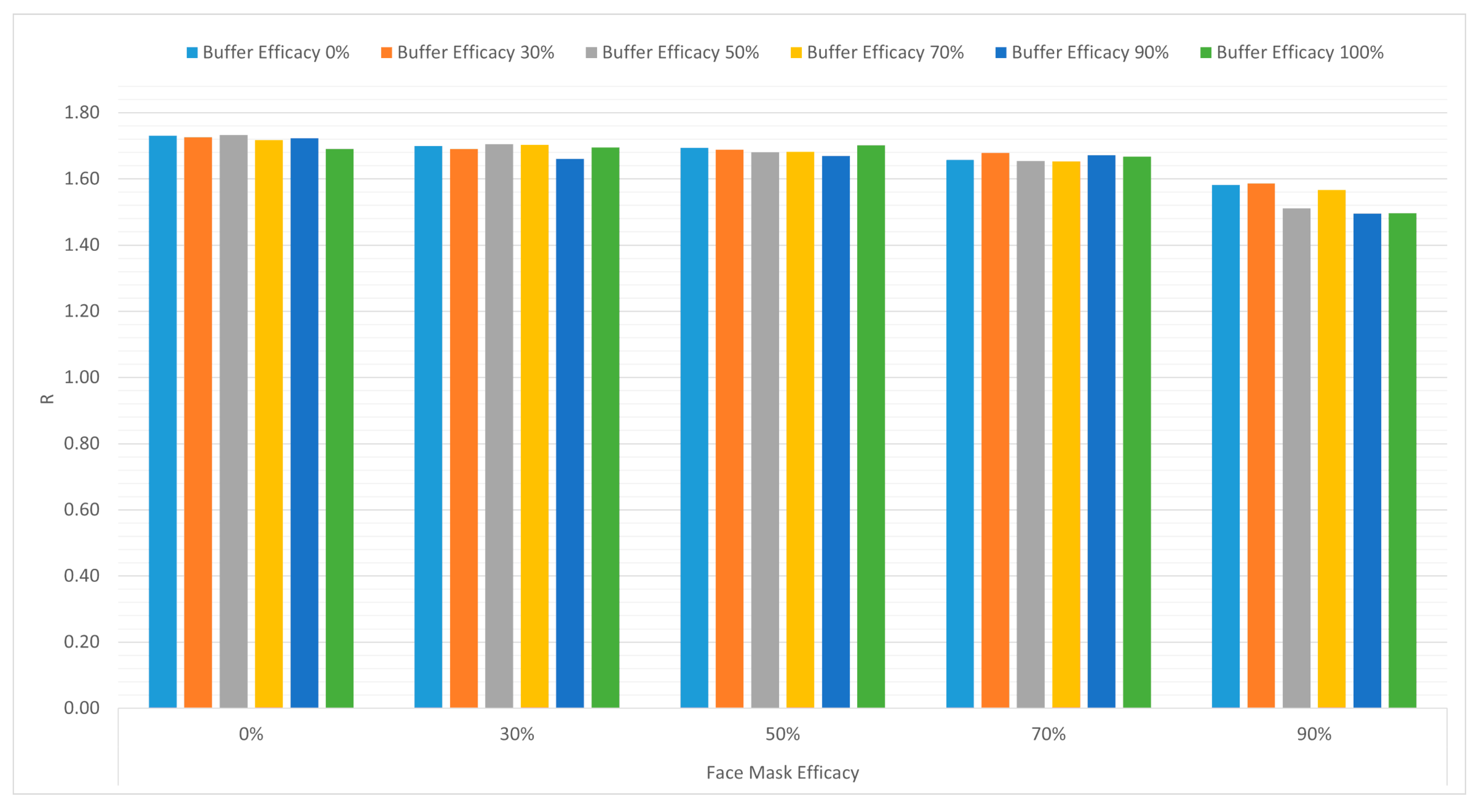
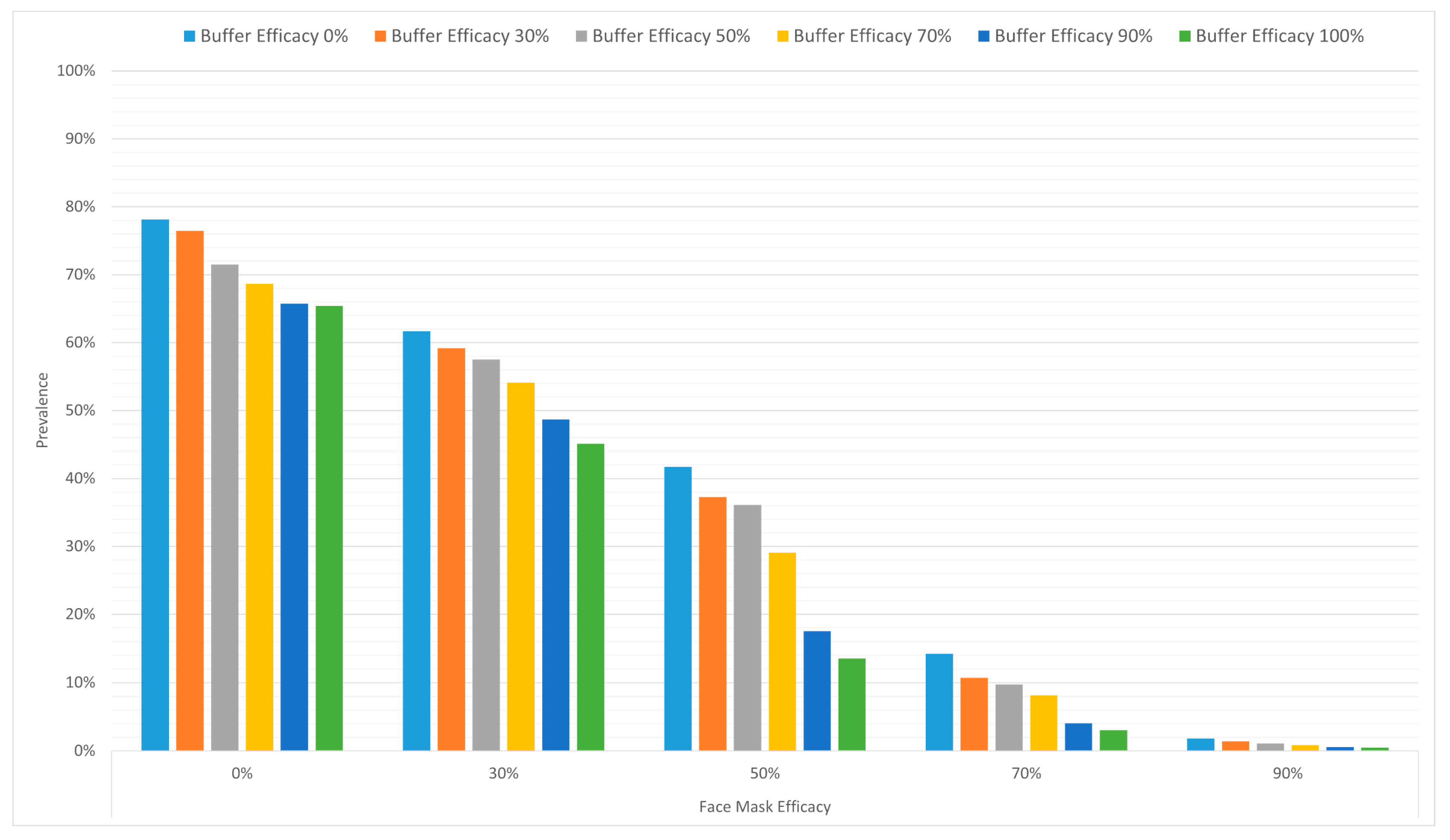
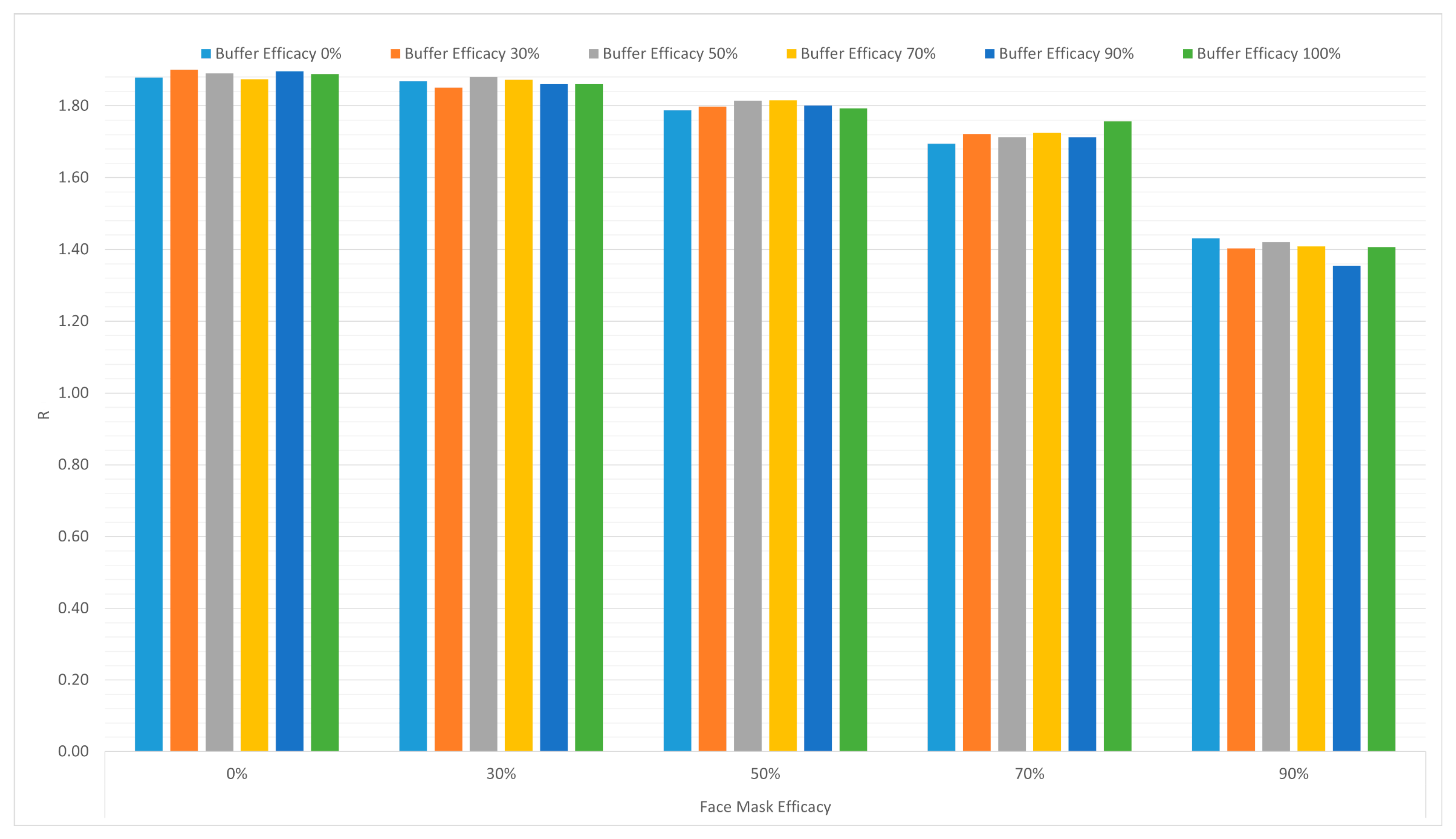
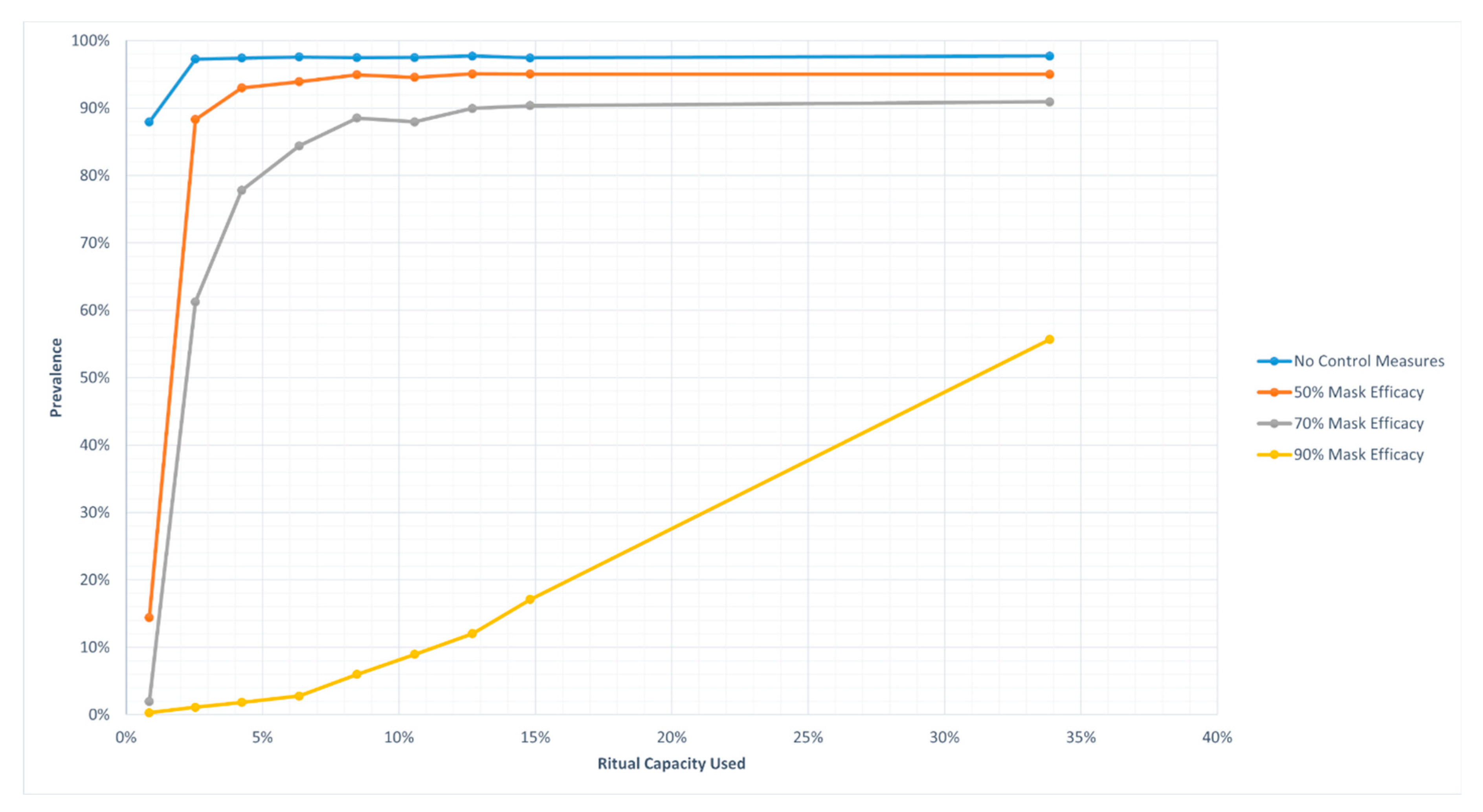
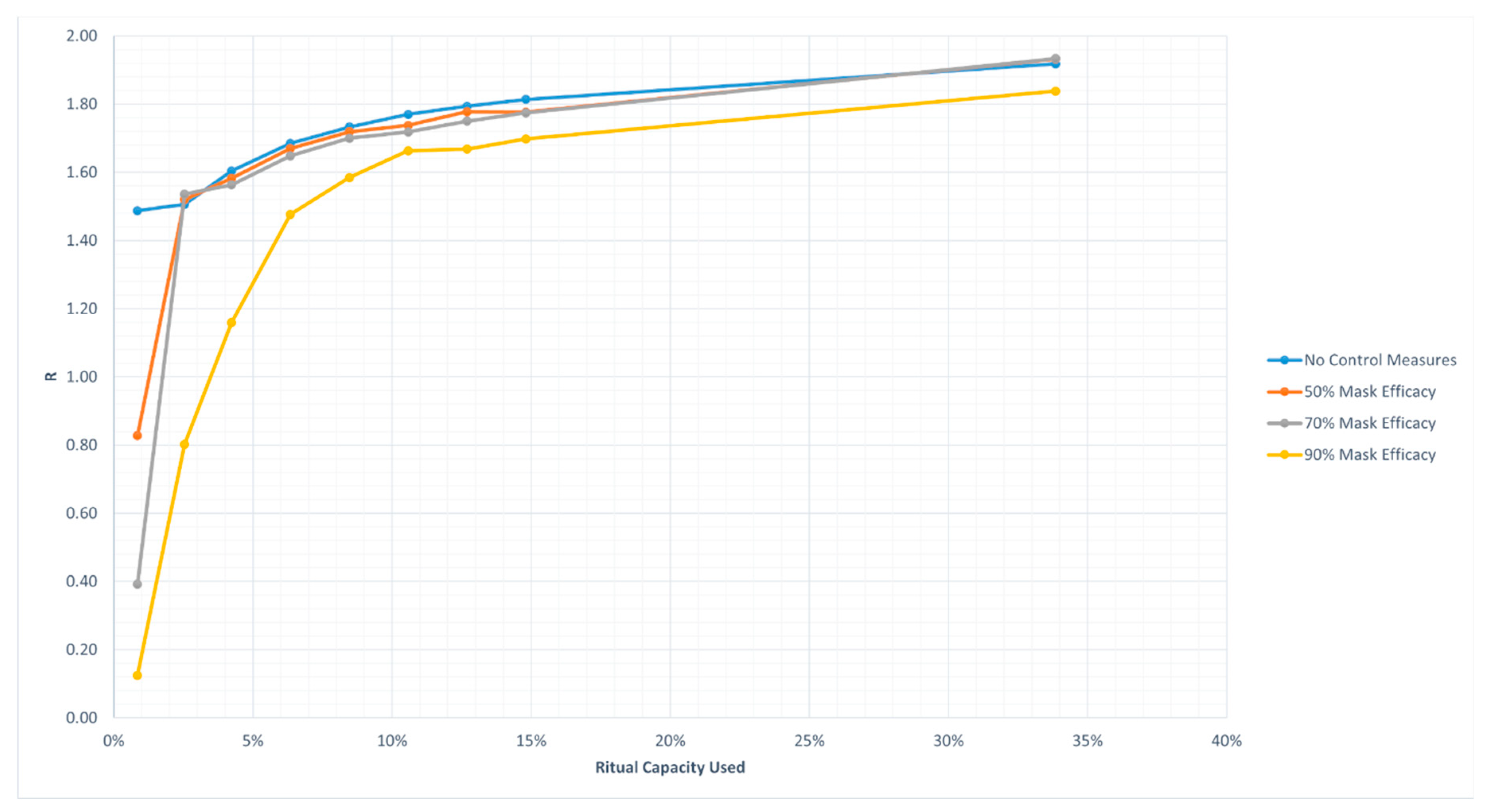
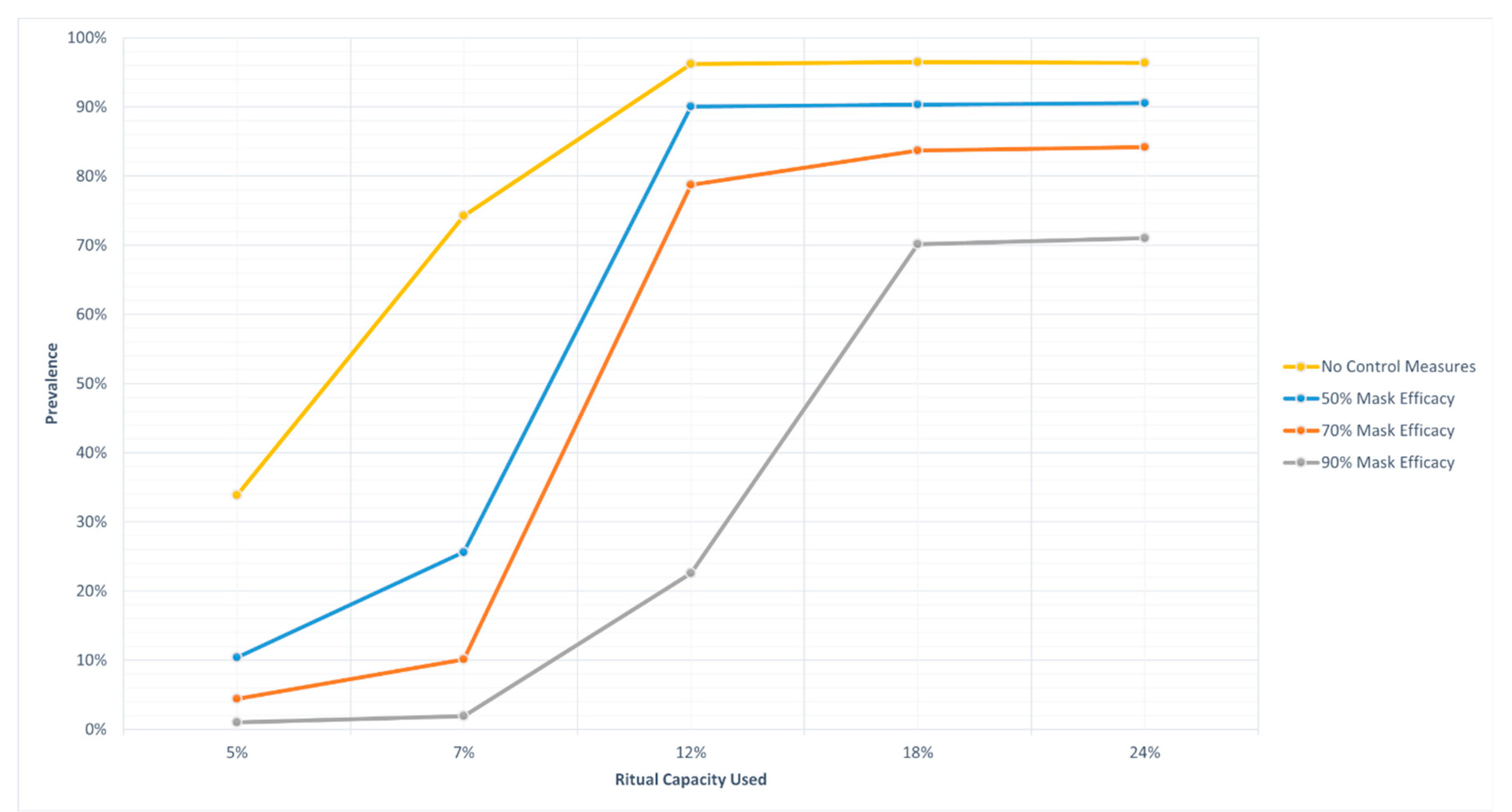
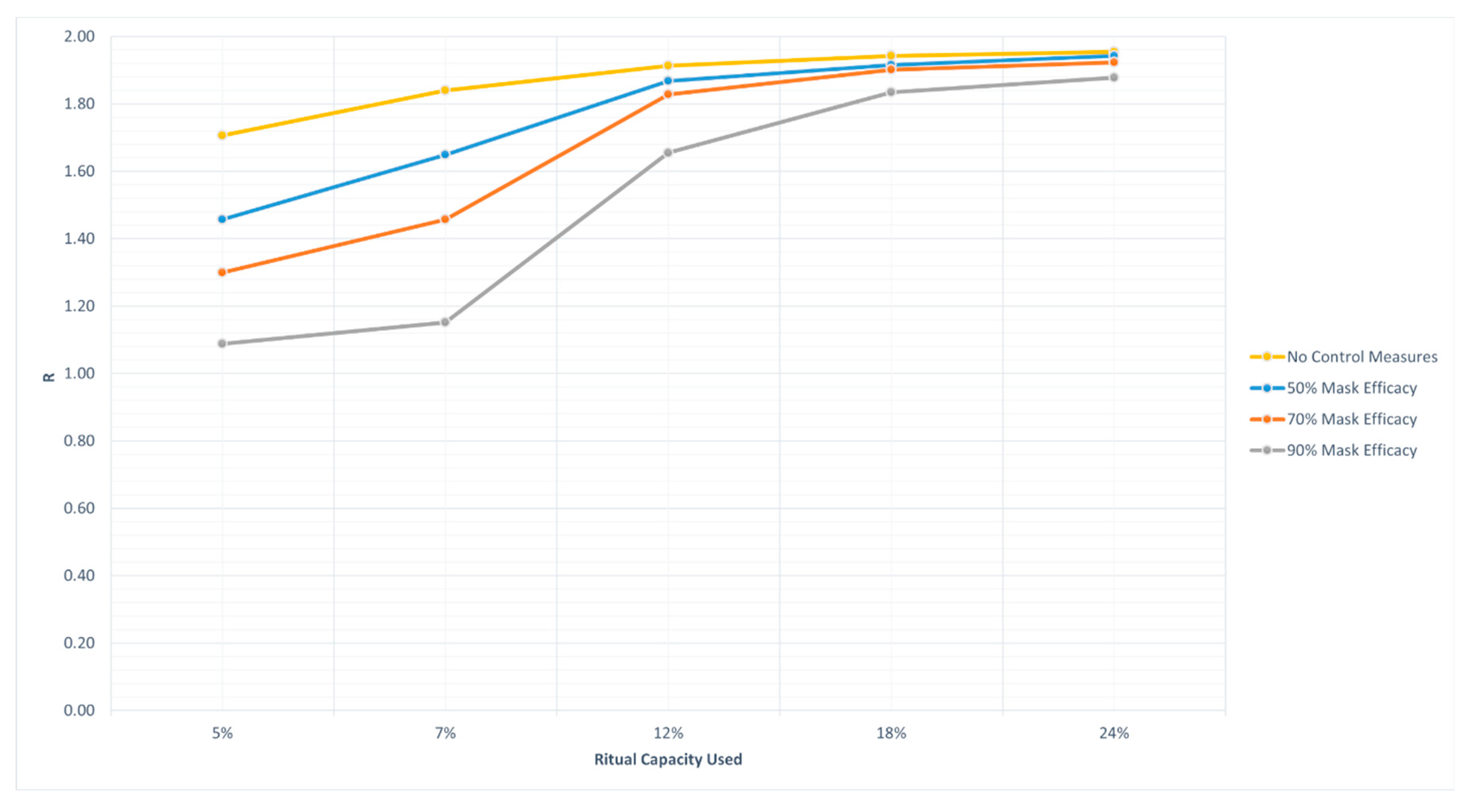
| Parameter | Description | Value | Source |
|---|---|---|---|
| Probability of being infected upon an infectious contact | 0.5% | - | |
| Probability an infected agent is asymptomatic | 17.9% | [33] |
Publisher’s Note: MDPI stays neutral with regard to jurisdictional claims in published maps and institutional affiliations. |
© 2021 by the authors. Licensee MDPI, Basel, Switzerland. This article is an open access article distributed under the terms and conditions of the Creative Commons Attribution (CC BY) license (https://creativecommons.org/licenses/by/4.0/).
Share and Cite
Al-Shaery, A.M.; Hejase, B.; Tridane, A.; Farooqi, N.S.; Jassmi, H.A. Agent-Based Modeling of the Hajj Rituals with the Possible Spread of COVID-19. Sustainability 2021, 13, 6923. https://doi.org/10.3390/su13126923
Al-Shaery AM, Hejase B, Tridane A, Farooqi NS, Jassmi HA. Agent-Based Modeling of the Hajj Rituals with the Possible Spread of COVID-19. Sustainability. 2021; 13(12):6923. https://doi.org/10.3390/su13126923
Chicago/Turabian StyleAl-Shaery, Ali M., Bilal Hejase, Abdessamad Tridane, Norah S. Farooqi, and Hamad Al Jassmi. 2021. "Agent-Based Modeling of the Hajj Rituals with the Possible Spread of COVID-19" Sustainability 13, no. 12: 6923. https://doi.org/10.3390/su13126923
APA StyleAl-Shaery, A. M., Hejase, B., Tridane, A., Farooqi, N. S., & Jassmi, H. A. (2021). Agent-Based Modeling of the Hajj Rituals with the Possible Spread of COVID-19. Sustainability, 13(12), 6923. https://doi.org/10.3390/su13126923







